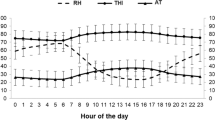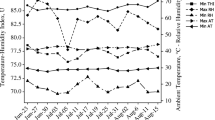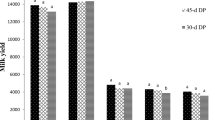Abstract
Heat stress generates a significant economic impact for the dairy industry in arid and semi-arid regions of the world, so that heat abatement is an important issue for dairy producers. The objective of this study was to evaluate effects of two short-term cooling periods on physiological and productive status of lactating Holstein cows during hot ambient temperatures. Thirty-nine multiparous cows were blocked by milk yield and assigned to one of three treatments including: control group (C), cows cooled before milking time (0500 and 1700 h daily, 1 h cooling); AM group, cows cooled at 1000 h and before milking (2 h cooling); and AM + PM group, cows cooled at 1100, 1500 and 2200 h, as well as before milking (4 h cooling). The cooling system was placed in the holding pen which the cows were moved through for cooling. Respiratory rate, and temperatures of thurl and right flank, were lower (P < 0.05) in cows from the AM + PM group than AM and C cows during the morning and afternoon. However, udder temperature was higher in the AM + PM group compared to AM and C groups during the afternoon, although lower than the AM group during the morning. Rectal temperature was similar in all groups. Thyroxin concentrations tended (P < 0.10) to be lower in AM + PM relative to the AM and C groups. The AM + PM group had higher (P < 0.05) milk production than C (18.70 vs. 17.43 kg, respectively), and AM + PM cows had a trend (P < 0.10) to increased milk energy output vs. the C and AM groups (13.75 vs. 13.18 and 13.15 Mcal, respectively). Protein and fat in milk, body condition score, glucose, cholesterol, triglycerides and triiodothyronine were similar among the groups. Four hours of cooling with spray and fans during severe summer temperatures only modestly improved milk yield of lactating Holstein cows.
Similar content being viewed by others
References
Arieli A, Adin G, Bruckental I (2004) The effect of protein intake on performance of cows in hot environmental temperatures. J Dairy Sci 87:620–629
Armstrong DV (1994) Heat stress interaction with shade and cooling. J Dairy Sci 77:2044–2050
Avendaño L, Alvarez FD, Correa A, Saucedo JS, Robinson PH, Fadel JG (2006) Effect of cooling Holstein cows during the dry period on postpartum performance under heat stress conditions. Livest Sci 105:198–206
Avendaño L, Alvarez FD, Correa A, Saucedo JS, Rivera F, Verdugo FJ, Arechiga CF, Robinson PH (2007) Evaluation of a cooling system used in the dry period of dairy cattle in summer. Tec Pec Mex 45:209–225
Barbano DM, Lynch JM, Fleming JR (1991) Direct and indirect determination of true protein content of milk by Kjeldahl analysis: collaborative study. JAOAC 74:281–288
Chacón AD, Giner ME, Vázquez VM, Roe SM, Maldonado SM, Lindquist H, Strode B, Anderson R, Quiroz C, Schreiber J (2010) Emisión de gases de efecto Invernadero en Baja California y proyecciones de casos de referencia 1990-2025. 1ra Edición. Comisión de Cooperación Ecológica Fronteriza. Cd. Juárez, Chih., México
Chaiyabutr N, Chanpongsang S, Suadsong S (2008) Effects of evaporative cooling on the regulation of body water and milk production in crossbred Holstein cattle in a tropical environment. Int J Biometeorol 52:575–585
Collier RJ, Dahl GE, VanBaale MJ (2006) Major advances associated with environmental effects on dairy cattle. J Dairy Sci 89:1244–1253
Collier RJ, Collier JL, Rhoads RP, Baumgard LH (2008) Genes involved in the bovine heat stress response. J Dairy Sci 91:445–454
Coppola CL, Collier RJ, Enns RM (2002) Evaluation of thermal status of cattle using infrared technology. Proceedings, Western Section, American Society of Animal Science, vol 53, Colorado State University, Fort Collins, June 19–21, 2002
Fullerton FM, Fleet IR, Heap RB, Hart IC, Mepham TB (1989) Cardiovascular responses and mammary substrate uptake in Jersey cows treated with pituitary-derived growth hormone during late lactation. J Dairy Sci 56:27–35
García E (1985) Modificaciones al sistema de clasificación climática de Köeppen (para adaptarlo a las condiciones de la República Mexicana). Instituto de Geografía, Universidad Nacional Autónoma de México, 2a edición. DF, México
Hahn GL (1999) Dynamic responses of cattle to thermal heat loads. J Dairy Sci 77:10–20
Hart IC, Bines JH, Morant SV (1978) Endocrine control of energy metabolism in the cow. Correlations of hormones and metabolites in high and low yielding cows for age of lactation J Dairy Sci 62:270–277
Hurley WL, Convey EM, Leung K, Edgerton LA, Hemken RW (1980) Bovine prolactin, TSH, T4 and T3 concentrations as affected by tall fescue summer toxicosis and temperature. J Anim Sci 51:374–379
Igono MO, Bjotvedt G, Sanford-Crane HT (1992) Environmental profile and critical temperature effects on milk production of Holstein cows in desert climate. Int J Biometeorol 36:77–87
Igono MO, Johnson HD, Steevens BJ, Krause GF, Shanklin MD (1987) Physiological, productive, and economic benefits of shade, spray, and fan system versus shade for Holstein cows during summer heat. J Dairy Sci 70:1069–1079
International Dairy Federation (IDF) (1991) Milk and milk products-fat content. General guidance on the use of butyrometric methods. FIL-IDF Stand. 52. International Dairy Federation, Brussels, Belgium
Kadzere CT, Morphy MR, Silanikove N, Maltz E (2002) Heat stress in lactating dairy cow: a review. Livest Prod Sci 77:59–91
Kesner JS, Leung K, Convey EM (1979) Effect of milking and ambient temperature on thyrotropin concentration in serum of cattle. Proc Soc Exp Biol Med 161:38–40
Littell RC, Milliken GA, Stroup WW, Wolfinger RD (1996) SAS System for Mixed Models. SAS Institute Inc., Cary, NC
Madon RJ, Martin S, Davies A, Fawcett HAC, Flint DJ, Baldwin SA (1990) Identification and characterization of glucose transport proteins in plasma membrane and golgi vesicle-enriched fractions prepared from lactating rat mammary gland. Biochem J 272:99–105
McDowell GH, Gooden JM, Leenanuruksa D, Jois M, English AW (1987) Effects of exogenous growth hormone on milk production and nutrient uptake by muscle and mammary tissues of dairy cows in mid lactation. Austr J Biol Sci 40:295–306
Mepham TB (1993) The development of ideas on the role of glucose in regulating milk secretion. Aust J Agric Res 44:508–522
National Research Council (NRC) (2001) Nutrient requirements of dairy cattle, 7th edn. National Academy Press, Washington, DC
Purwanto BP, Abo Y, Sakamoto R, Furumoto F, Yamamoto S (1990) Diurnal patterns of heat production and heart rate under thermoneutral conditions in Holstein Friesian cows differing in milk production. J Agric Sci (Camb) 114:139–142
Sandles LD, Sun YXD, Cruz AGC, McDowell GH, Gooden JM (1988) Response of lactating ewes to exogenous growth hormone: short and long-term effects of productivity and tissue utilization of key metabolites. Aust J Biol Sci 41:357–370
SAS (2004) User’s guide. Software released 9.12. SAS Institute Inc., Cary, NC
Silanikove N (2000) Effects of heat stress on the welfare of extensively managed domestic ruminants. Livest Prod Sci 67:1–18
St Pierre NR, Cobanov B, Schnitkey G (2003) Economic losses from heat stress by US livestock industries. J. Dairy Sci 86 (E Suppl) E52–E77
Tyrrell HF, Reid JT (1965) Prediction of the energy values of cow’s milk. J Dairy Sci 48:1215–1223
Vanjonack WJ, Johnson HD (1975) Effects of moderate heat and milk yield on plasma thyroxin in cattle. J Dairy Sci 58:507–511
West JW (1999) Nutritional strategies for managing the heat-stressed dairy cow. J Anim Sci 77:21–35
Wildman EE, Jones GM, Wagner PE, Boman RL, Troutt HF Jr, Lesch TN (1982) A dairy cow body condition scoring system and its relationship to selected production characteristics. J Dairy Sci 65:495–501
Yousef MK (1985) Heat production: Mechanisms and regulation. In: Yousef MK (ed) Stress physiology in livestock, vol 1. CRC Press, Inc, Boca Raton, pp 47–54
Acknowledgments
The authors appreciate MVZ Domingo Alberto Méndez Otero, the owner of the dairy herd Santo Domingo, for his excellent cooperation in permitting us to use his cows. Also, to Distribuidora Eléctrica AVEHER, S.A. de C.V., for his worthwhile support during the equipment acquisition and installation, in particular to Jorge G. Avendaño Reyes.
Author information
Authors and Affiliations
Corresponding author
Rights and permissions
About this article
Cite this article
Avendaño-Reyes, L., Hernández-Rivera, J.A., Álvarez-Valenzuela, F.D. et al. Physiological and productive responses of multiparous lactating Holstein cows exposed to short-term cooling during severe summer conditions in an arid region of Mexico. Int J Biometeorol 56, 993–999 (2012). https://doi.org/10.1007/s00484-011-0510-x
Received:
Revised:
Accepted:
Published:
Issue Date:
DOI: https://doi.org/10.1007/s00484-011-0510-x




